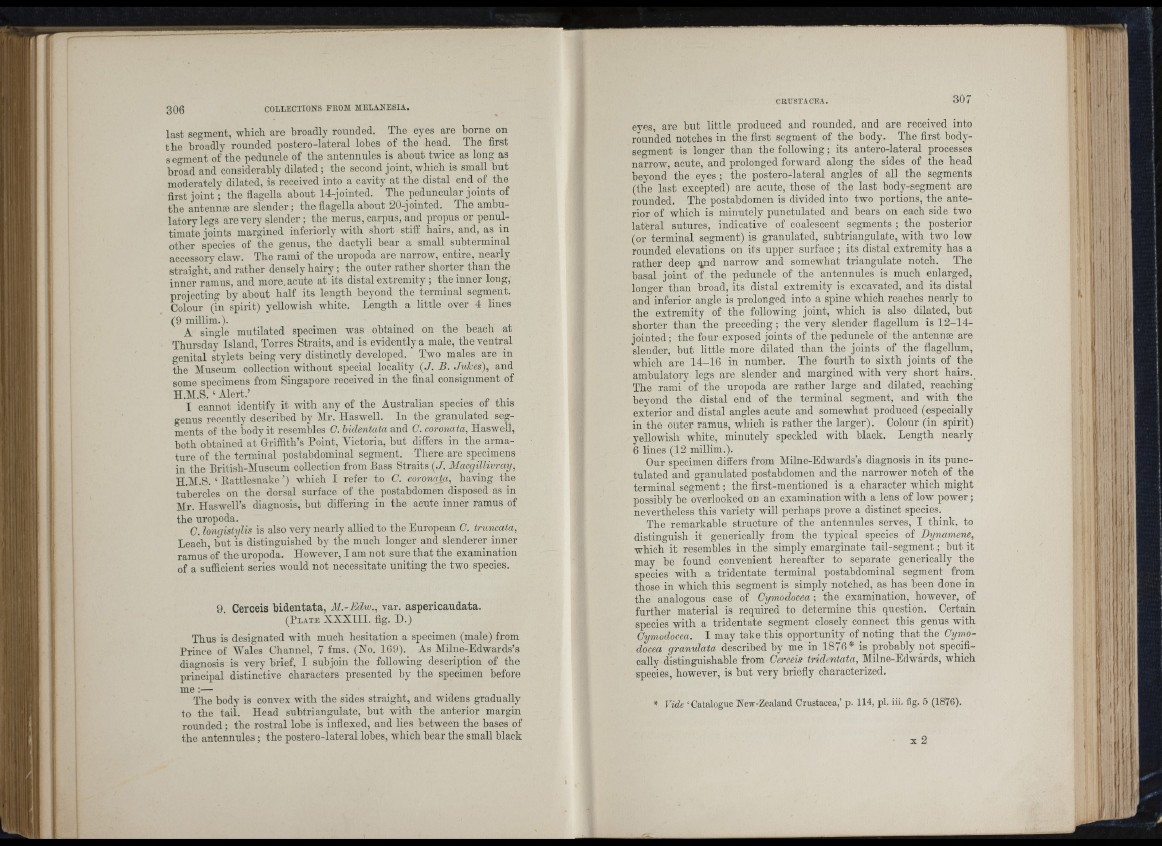
306 COLLECTIONS FKOM MELANESIA.
I
last segment, which are broadly rounded. The eyes are borne on
th e broadly rounded postero-lateral lobes of the head. The first
segment of the peduncle of the antennules is about twice as long as
broad and considerably dilated ; the second joint, which is small but
moderately dilated, is received into a cavity at the distal end of the
first jo in t ; the flagella about 14-jointed. The peduncular joints of
the antenn® are slender ; the flagella about 20-joiuted. The ambulatory
legs are very slender ; the merus, carpus, aud propus or penultimate
joints margined inferiorly with short stiff hairs, and, as in
other species of the genus, the dactyli bear a small subterminal
accessory claw. The rami of tho uropoda are narrow, entire, nearly
straight, and rather densely hairy ; the outer rather shorter than the
inner ramns, and more, acute at its distal extremity ; the inner long,
projecting by about half its length beyond the terminal segment.
Colour (in spirit) yellowish white. Length a little over 4 lines
(9 millim.). .
A single mutilated specimen was obtained on the beach at
Thursday Island, Torres Straits, and is evidently a male, the ventral
genital stylets being very distinctly developed. Two males are in
the Museum collection without special locality (J. B. Jukes), and
some specimens from Singapore received in the final consignment of
H.Al.S. ‘ Alert.’ .
I cannot identify it with any of the Australian species of this
genus recently described by Air. Haswell. In the granulated segments
of the body it resembles G. hidentata and C. coronata, Haswell,
both obtained at Griffith’s Point, Victoria, hut differs in the armature
of the terminal postahdominal segment. There are specimens
in the British-Aluseum collection from Bass Straits (J. Alacgillivray,
H.M.S. ‘ Battlesnake ’) which I refer to C. coronata, _ having the
tubercles on the dorsal surface of the postahdomen disposed as in
Mr. Haswell’s diagnosis, hut differing in the acute inner ramus of
the uropoda.
C. longistylis is also very nearly allied to the European 0. truncata,
Leach, but is distinguished by the much longer and slenderer inner
ramus of the uropoda. However, I am not sure th at the examination
of a sufficient series would not necessitate uniting the two species.
9 Cerceis hidentata, AI.-Edw., var. aspericaudata.
( P l a t e X X X III. fig. D.)
Thus is designated with much hesitation a specimen (male) from
Prince of AA*ales Channel, 7 fms. (No. 169). As Alilne-Edwards’s
diagnosis is very brief, I subjoin the following description of the
principal distinctive characters presented by the specimen before
me :—
The body is convex with the sides straight, and widens gradually
to the tail. Head suhtriangnlate, hut with the anterior margin
rounded; the rostral lobe is inflexed, and lies between the bases of
the antennules; the postero-lateral lobes, which bear the small black
I: ri
307
eves, are but little produced and rounded, and are received into
rounded notches in the first segment of the body. The first body-
segment is longer than the following; its antero-lateral processes
narrow, acute, and prolonged forward along the sides of the head
beyond the eyes ; the postero-lateral angles of all the segments
(the last excepted) are acute, those of the last hody-segment are
rounded. The postahdomen is divided into two portions, the anterior
of which is minutely punctulated and hears on each side two
lateral sutures, indicative of coalescent segments ; the posterior
(or terminal segment) is granulated, subtriangulate, with two low
rounded elevations on its upper surface ; its distal extremity has a
rather deep q^id narrow and somewhat triangulate notch. The
hasal joint of the peduncle of the antennules is much enlarged,
longer than broad, its distal extremity is excavated, and its distal
and inferior angle is prolonged into a spine which reaches nearly to
the extremity of the following joint, which is also dilated, but
shorter than the preceding ; the very slender flagellum is 12-14-
jo in ted ; the four exposed joints of the peduncle of the antennae are
slender, bnt little more dilated than the joints of the flagellum,
which are 14-16 in number. The fourth to sixth joints of the
ambulatory legs are slender and margined with very short hairs.
The rami of the uropoda are rather large and dilated, reaching
beyond the distal end of the terminal segment, and with the
exterior and distal angles acute and somewhat produced (especially
in the outer ramus, which is rather the larger). Colour (in spirit)
yellowish white, minutely speckled with black. Length nearly
6 lines (12 millim.).
Our specimen differs from Alilne-Edwards’s diagnosis in its punctulated
and granulated postahdomen and the narrower notch of the
terminal segment; the first-mentioned is a character which might
possibly be overlooked on an examination with a lens of low power;
nevertheless this variety will perhaps prove a distinct species.
The remarkable structure of the antennules serves, I think, to
distinguish it generically from the typical species of Dynamene,
which it resembles in the simply emarginate ta il- s e gm e n tb u t it
may he found convenient hereafter to separate generically the
species with a tridentate terminal postahdominal segment from
those in which this segment is simply notched, as has been done in
the analogous case of Cymodocea; the examination, however, of
further material is required to determine this question. Certain
species with a tridentate segment closely connect this genus with
Cymodocea. I may take this opportunity of noting th at the Cymodocea
granulata described by me in 1876* is probably not specifically
distinguishable from Cerceis tridentata, Alilne-Edwards, which
species, however, is hut very briefly characterized.
* Vide ‘Catalogue New-Zealand Crustacea,’ p. 114, pi. iii. fig. 5 (1876).
* *
,, J
I J SB :
h i :
4 i
IL U
d ‘ :
i i I
te .
! I
;i ■' I (